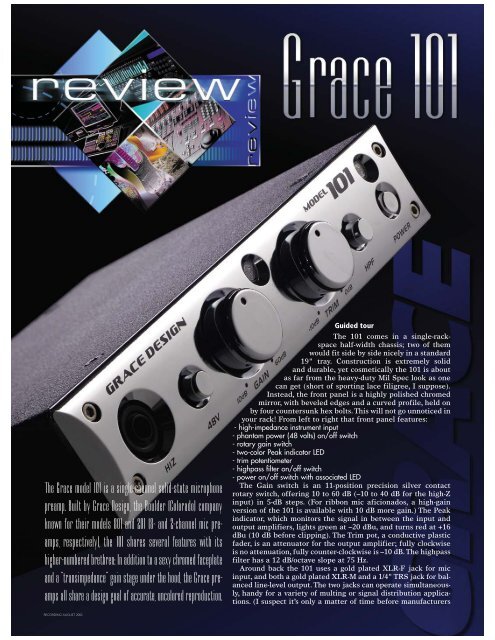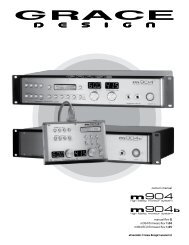The Grace model 101 is a single-channel solid-state ... - Grace Design
The Grace model 101 is a single-channel solid-state ... - Grace Design
The Grace model 101 is a single-channel solid-state ... - Grace Design
You also want an ePaper? Increase the reach of your titles
YUMPU automatically turns print PDFs into web optimized ePapers that Google loves.
<strong>The</strong> <strong>Grace</strong> <strong>model</strong> <strong>101</strong> <strong>is</strong> a <strong>single</strong>-<strong>channel</strong> <strong>solid</strong>-<strong>state</strong> microphone<br />
preamp. Built by <strong>Grace</strong> <strong>Design</strong>, the Boulder (Colorado) company<br />
known for their <strong>model</strong>s 801 and 201 (8- and 2-<strong>channel</strong> mic preamps,<br />
respectively), the <strong>101</strong> shares several features with its<br />
higher-numbered brethren: In addition to a sexy chromed faceplate<br />
and a “transimpedance” gain stage under the hood, the <strong>Grace</strong> preamps<br />
all share a design goal of accurate, uncolored reproduction.<br />
RECORDING AUGUST 2002<br />
Guided tour<br />
<strong>The</strong> <strong>101</strong> comes in a <strong>single</strong>-rackspace<br />
half-width chass<strong>is</strong>; two of them<br />
would fit side by side nicely in a standard<br />
19" tray. Construction <strong>is</strong> extremely <strong>solid</strong><br />
and durable, yet cosmetically the <strong>101</strong> <strong>is</strong> about<br />
as far from the heavy-duty Mil Spec look as one<br />
can get (short of sporting lace filigree, I suppose).<br />
Instead, the front panel <strong>is</strong> a highly pol<strong>is</strong>hed chromed<br />
mirror, with beveled edges and a curved profile, held on<br />
by four countersunk hex bolts. Th<strong>is</strong> will not go unnoticed in<br />
your rack! From left to right that front panel features:<br />
- high-impedance instrument input<br />
- phantom power (48 volts) on/off switch<br />
- rotary gain switch<br />
- two-color Peak indicator LED<br />
- trim potentiometer<br />
- highpass filter on/off switch<br />
- power on/off switch with associated LED<br />
<strong>The</strong> Gain switch <strong>is</strong> an 11-position prec<strong>is</strong>ion silver contact<br />
rotary switch, offering 10 to 60 dB (–10 to 40 dB for the high-Z<br />
input) in 5-dB steps. (For ribbon mic aficionados, a high-gain<br />
version of the <strong>101</strong> <strong>is</strong> available with 10 dB more gain.) <strong>The</strong> Peak<br />
indicator, which monitors the signal in between the input and<br />
output amplifiers, lights green at –20 dBu, and turns red at +16<br />
dBu (10 dB before clipping). <strong>The</strong> Trim pot, a conductive plastic<br />
fader, <strong>is</strong> an attenuator for the output amplifier; fully clockw<strong>is</strong>e<br />
<strong>is</strong> no attenuation, fully counter-clockw<strong>is</strong>e <strong>is</strong> –10 dB.<strong>The</strong> highpass<br />
filter has a 12 dB/octave slope at 75 Hz.<br />
Around back the <strong>101</strong> uses a gold plated XLR-F jack for mic<br />
input, and both a gold plated XLR-M and a 1/4" TRS jack for balanced<br />
line-level output. <strong>The</strong> two jacks can operate simultaneously,<br />
handy for a variety of multing or signal d<strong>is</strong>tribution applications.<br />
(I suspect it’s only a matter of time before manufacturers
BY BOB ROSS<br />
start labeling th<strong>is</strong> feature “Zero Latency Monitor Output,”<br />
given th<strong>is</strong> common usage when tracking to digital audio<br />
workstations.) Both the XLR and TRS jacks can feed<br />
unbalanced sources, though <strong>Grace</strong> strongly recommends<br />
using cables which leave pin 3 (or the ring) open to minimize<br />
d<strong>is</strong>tortion. A power input jack connects to the included<br />
6V/800 mA wall wart.<br />
<strong>The</strong> inside scoop<br />
Inside, the <strong>Grace</strong> <strong>101</strong> <strong>is</strong> a tribute to pr<strong>is</strong>tine manufacturing<br />
techniques. <strong>The</strong> circuit board <strong>is</strong> spacious and<br />
robust, populated with meticulously laid out surfacemount<br />
components. “No user serviceable parts” indeed,<br />
but also very likely no need for service: the <strong>101</strong> looks like<br />
it was designed to withstand a mortar attack.<br />
Pur<strong>is</strong>ts will appreciate that there are no electrolytic<br />
capacitors in the audio path. Th<strong>is</strong> preamp <strong>is</strong> transformerless,<br />
its circuitry fully balanced (electronically) throughout.<br />
Even the front-panel instrument input <strong>is</strong> balanced,<br />
though obviously it will also work with unbalanced guitars,<br />
synths, the usual suspects. According to <strong>Grace</strong>, the<br />
“transimpedance” gain stage offers constant bandwidth<br />
over a wide gain range, and it’s not prone to slew rate limiting,<br />
yielding a faster, more articulate reproduction of<br />
transients. For the number-hungry, two l<strong>is</strong>ted specs bear<br />
th<strong>is</strong> out and are worth noting: Frequency response <strong>is</strong> ±3 dB<br />
from 4.5 Hz–390 kHz (not a m<strong>is</strong>print; that’s three hundred<br />
ninety kilohertz!), and the output amplifiers possess a<br />
slew rate of 2000 volts per microsecond. (For compar<strong>is</strong>on,<br />
quite a few well-respected pro audio products have<br />
achieved stellar sound using output devices in the 13–35<br />
V/µs range.)<br />
But you don’t l<strong>is</strong>ten to specs, and you don’t use a mic pre<br />
on the test bench with the lid off. It’s all about the<br />
sound...or, in the case of the <strong>Grace</strong> <strong>101</strong>, the lack of a<br />
sound.<br />
Different species of mic preamps<br />
Mic preamps can be grossly over-generalized as falling<br />
into one of two categories: <strong>The</strong>re are those that have a<br />
character<strong>is</strong>tic sonic signature, preamps that impart a<br />
d<strong>is</strong>tinctive and (hopefully) euphonic coloration to every<br />
signal that passes through them. <strong>The</strong>y are as much tone<br />
shapers, signal processors, literally d<strong>is</strong>tortion generators,<br />
as they are pure gain devices...and the best of these<br />
are coveted for their sound. <strong>The</strong>se are the Character preamps.<br />
And then there are the preamps that are windows—<br />
pure, pr<strong>is</strong>tine, transparent, inv<strong>is</strong>ible. <strong>The</strong>y contribute<br />
nothing to the signal, but divulge the limits of what the<br />
microphone <strong>is</strong> capable of resolving with exacting clarity<br />
and prec<strong>is</strong>ion. <strong>The</strong>se are the Truth preamps...and the best<br />
of these are coveted for their accuracy.<br />
<strong>The</strong> <strong>Grace</strong> <strong>101</strong> would appear to fall in the latter category.<br />
Almost to a fault. See, it’s very easy to appreciate a<br />
good Character preamp: Plug in a mic, turn up the gain,<br />
sing a little, “Man, that sounds awesome!”. <strong>The</strong> contribution<br />
<strong>is</strong> overt. <strong>The</strong> appeal of the <strong>Grace</strong> <strong>is</strong> in its lack of a contribution.<br />
Plug a mic into the <strong>101</strong>, turn up the gain, sing a<br />
little, “Man, that sounds...exactly like me singing.” On<br />
first l<strong>is</strong>ten, the thing about the <strong>Grace</strong> <strong>101</strong> that <strong>is</strong> most<br />
striking <strong>is</strong>...absolutely nothing. Only after repeated concentrated<br />
l<strong>is</strong>tening evaluations do the <strong>101</strong>’s stringent<br />
standards become apparent.<br />
First honors—the flute<br />
My first session was recording solo flute. I selected an<br />
AKG C 535 EB, a small-diaphragm cardioid condenser mic<br />
with a gentle lift above 2 kHz, parked it about 18" over the<br />
fingerholes, and plugged it into the <strong>Grace</strong> <strong>101</strong>. For compar<strong>is</strong>on,<br />
I had several other mic preamps to choose from,<br />
including a Demeter VTMP-2B (a 2-<strong>channel</strong> all-tube unit<br />
which costs considerably more than two <strong>channel</strong>s of <strong>Grace</strong><br />
<strong>101</strong> would), and the ubiquitous and affordable XDR preamps<br />
in a Mackie 1202 VLZ Pro, a unit I suspect many<br />
readers are familiar with.<br />
Setting the gain on the <strong>101</strong> was effortless; with the Trim<br />
pot fully clockw<strong>is</strong>e, 50 dB on the Gain control brought the<br />
level into the desired range. At least, I think it was 50 dB;<br />
besides the maximum and minimum values, there are no<br />
markings around the Gain switch, so you have to count<br />
clicks if you want a specific amount of gain. I didn’t find<br />
th<strong>is</strong> to be an obstacle, as I’m usually looking at the meters<br />
on the tape deck or DAW when dialing in preamp gain<br />
anyway.<br />
What I did find annoying was the <strong>101</strong>’s black lettering<br />
on the lower curve of its chrome faceplate: Unless the <strong>101</strong><br />
<strong>is</strong> mounted above eye level, it <strong>is</strong> absolutely impossible to<br />
read any of the front panel designations, and even then a<br />
certain amount of squinting and head tilting was necessary.<br />
I found myself m<strong>is</strong>taking the phantom power switch<br />
for the highpass filter switch on quite a few occasions<br />
until I forced myself to memorize their locations.<br />
Anyway, there’s my flute sound. Yep, sounds like a flute.<br />
Umm... (fingers drumming on tabletop)...right. Do I like<br />
it? Uh, sure, what’s not to like? Nice balance of breath<br />
sounds/attack and fundamental, just enough key click to<br />
know it’s not a sample, hmm, you can really hear the room<br />
sound supporting the long tones...guess I’ll print it. Dumdee-dum-dee-dum....<br />
So. That’s the <strong>Grace</strong> <strong>101</strong>. I, uh, guess<br />
maybe I’ll swap out the <strong>Grace</strong> and hear how the Mackie<br />
does on th<strong>is</strong> flute.<br />
Oh.<br />
Oh!!!<br />
Where’d my natural timbral balance go? Where’d the<br />
room tone go? I don’t mean to suggest that the C 535 EB<br />
through the Mackie VLZ Pro sounded bad; it was certainly<br />
a perfectly usable flute sound. But little elements that<br />
had contributed to the “suspension of d<strong>is</strong>belief,” the<br />
things that made you forget you were l<strong>is</strong>tening to a recording,<br />
were m<strong>is</strong>sing. I patched the <strong>Grace</strong> <strong>101</strong> back in. Ah,<br />
there it was. Subtle, barely perceptible details of the flute<br />
sound returned. <strong>The</strong> <strong>Grace</strong>’s ability to translate early<br />
reflections to a tangible three-dimensional room sound<br />
(th<strong>is</strong> <strong>is</strong> from a <strong>single</strong> mono mic, remember) was stunning.<br />
Not stunning in the “Omigosh, that’s amazing!” sense;<br />
just...sublime. August. Rewarding.<br />
Gradually I came to appreciate the strengths of the<br />
<strong>Grace</strong> <strong>101</strong>. While it adds nothing, it also seems to m<strong>is</strong>s<br />
nothing. Whatever the mic captures <strong>is</strong> amplified and portrayed<br />
in acute, natural detail. Qualities that are specific<br />
to a particular mic are also revealed under th<strong>is</strong> refined<br />
microscope, as became evident during my next session,<br />
while recording electric guitar.<br />
RECORDING AUGUST 2002
Guitar<br />
For th<strong>is</strong> particular recording I<br />
found myself with three dynamic<br />
mics clustered in front of a vintage<br />
Altec 12" speaker in a ported cabinet.<br />
Especially for “traditional” rock guitar<br />
tracks I like to blend multiple<br />
mics, making minor positional adjustments<br />
to use their in- or out-of-phaseness<br />
for spectral variety. On th<strong>is</strong> day<br />
the mics included a Shure SM57, an<br />
Electro-Voice RE15, and an Electro-<br />
Voice 635a. I started with the 57 into<br />
the <strong>Grace</strong> <strong>101</strong>, but swapped mics and<br />
preamps around with joyful impunity.<br />
<strong>The</strong> <strong>Grace</strong> seemed dead set on confounding<br />
all my preconceived notions<br />
about what these mics “really” sound<br />
like. Whenever I’d solo a mic through<br />
the <strong>101</strong>, I’d hear some quality, some<br />
aspect of its timbral fabric, that was<br />
not evident through the Demeter or<br />
the Mackie. Some of those qualities<br />
were details that improved upon the<br />
other preamps, while others were conspicuous<br />
by the om<strong>is</strong>sion of some element<br />
that was a desirable part of the<br />
guitar sound.<br />
In general, it seemed as though the<br />
<strong>Grace</strong> was magnifying both the<br />
strengths and the weaknesses of these<br />
particular microphones: <strong>The</strong> peakiness<br />
of the SM57 in the 3 kHz range was<br />
more clearly defined, yet deprived of<br />
some of its enchantment; the lack of<br />
proximity effect from the RE15 was<br />
more blatant, and revealed to potentially<br />
be either an asset or a liability; the<br />
bandwidth restrictions of the 635a were<br />
exposed in all their guitar-friendly glory.<br />
Ultimately I found the slightly thickened,<br />
“chocolately” tube/transformer<br />
coloration of the Demeter to be more<br />
complimentary to the canonical rock-<br />
’n’roll electric guitar sounds th<strong>is</strong> project<br />
warranted. But the <strong>Grace</strong>’s ability to<br />
extract every ounce of information from<br />
whatever mic was plugged into it <strong>is</strong><br />
clearly an impressive and valuable feat.<br />
Traffic ambience—a test<br />
While sampling stereo traffic ambience<br />
with a coincident pair of AKG C<br />
451 B mics, I used the <strong>Grace</strong> on one<br />
<strong>channel</strong> to directly compare its sound<br />
to either the Demeter or the Mackie.<br />
Not surpr<strong>is</strong>ingly, in th<strong>is</strong> context the differences<br />
appeared clear-cut—making<br />
it a pointless technique for actually<br />
capturing cohesive stereo tracks, but<br />
quite edifying for <strong>is</strong>olating the <strong>101</strong>’s<br />
sonic character<strong>is</strong>tics. (<strong>The</strong> random but<br />
stat<strong>is</strong>tically uniform d<strong>is</strong>tribution of fre-<br />
RECORDING AUGUST 2002<br />
quencies in d<strong>is</strong>tant city traffic bears a<br />
remote resemblance to pink no<strong>is</strong>e,<br />
making it a convenient source for identifying<br />
gross response anomalies in an<br />
audio chain.)<br />
<strong>The</strong> word “smooth” came to mind.<br />
Compared to either of the other preamps,<br />
the <strong>Grace</strong> <strong>101</strong> had a less pronounced<br />
emphas<strong>is</strong> in the upper<br />
midrange, allowing the microphone’s<br />
extended high end to be more readily<br />
perceived without harshness or d<strong>is</strong>proportionate<br />
brightness. Also apparent<br />
was the very linear bass and lower<br />
midrange of the <strong>101</strong>: It reproduced<br />
details in the 150–600 Hz reg<strong>is</strong>ter with<br />
an openness and a neutrality that<br />
gave ambience a natural “fullness”<br />
without sounding “thick” or “fat.”<br />
<strong>The</strong> quickness of the output electronics<br />
seemed evident whenever<br />
transients occurred; no matter how<br />
closely I matched <strong>channel</strong> levels during<br />
steady-<strong>state</strong> signals, percussive<br />
impulses cons<strong>is</strong>tently reg<strong>is</strong>tered higher<br />
and faster on the <strong>channel</strong> through<br />
the <strong>Grace</strong>. Overall the <strong>101</strong> presented<br />
a seemingly unbiased window that<br />
extended over the entire audio range<br />
with no conspicuous peaks or dips, no<br />
obvious d<strong>is</strong>tortions or shortcomings.<br />
Th<strong>is</strong> neutrality may work against it<br />
at times. Using the high-impedance<br />
instrument input was rarely gratifying,<br />
despite the fact that there was<br />
nothing “wrong” at all with the sound<br />
from the guitars and basses I auditioned.<br />
Makes you realize how invaluable<br />
the subtle coloration of “character”<br />
preamps and direct boxes can be<br />
when recording direct instruments.<br />
<strong>The</strong> <strong>101</strong> sounded fine: clean, cr<strong>is</strong>p,<br />
round, full...and perhaps just a little<br />
bit boring. Its accuracy comes at the<br />
expense of mojo. However, the <strong>101</strong><br />
might be the perfect DI for instruments<br />
that are destined for re-amplification;<br />
it outputs as unaltered a<br />
reproduction of your direct instrument<br />
sound as conceivable, leaving a<br />
tabula rasa for subsequent processing.<br />
Input impedance <strong>is</strong> 1 Megohm,<br />
making it compatible with the most<br />
finicky vintage pickups and piezos.<br />
Vocals<br />
My final sessions with the <strong>Grace</strong><br />
<strong>101</strong> were vocal overdubs (once again<br />
featuring the beautiful and talented<br />
torch singer Betsy Heart). Due to the<br />
depleted microphone inventory we<br />
had available, our choices came down<br />
to an MXL 2001P (one of the least<br />
expensive large-diaphragm condenser<br />
mics on the market) and a Sennhe<strong>is</strong>er<br />
MD441U (arguably one of the finest<br />
moving-coil dynamic mics ever made).<br />
We started with the MXL into the<br />
<strong>Grace</strong> <strong>101</strong>. Previous sessions with<br />
Betsy singing into the 2001P had yielded<br />
a slightly strident tone with a tad<br />
too much sibilance. I’ve also noticed<br />
that the built-in preamps in many<br />
inexpensive consoles can exacerbate<br />
that quality to a detrimental degree.<br />
Yet into the <strong>101</strong> th<strong>is</strong> inexpensive mic<br />
sounded so smooth and sweet I had to<br />
repatch it into the Mackie XDR preamp<br />
just to remind myself that I hadn’t<br />
imagined those previous anomalies.<br />
Yep, that’s what I’d remembered: A<br />
slight graininess, a hard edge to consonants<br />
and high frequency transients, a<br />
closed-in smearing of detail, and a 5 or<br />
6 kHz peak that just makes digital<br />
recorders go “SPLAT!” But plug the<br />
mic back into the <strong>Grace</strong> <strong>101</strong>—and now<br />
it’s Courvo<strong>is</strong>ier. Yes, the peak was still<br />
there, but it was somehow more manageable,<br />
more integrated into the<br />
whole vocal sound. <strong>The</strong> <strong>Grace</strong> <strong>101</strong> may<br />
very well elevate cheap condenser<br />
mics from an economic necessity to a<br />
viable creative color in their own right.<br />
With a bona fide prestige mic like<br />
the Sennhe<strong>is</strong>er 441 (atypical perhaps,<br />
but prestigious nonetheless), the <strong>Grace</strong><br />
could really shine. Textural nuances in<br />
Betsy’s low alto were reproduced with<br />
impressive clarity and focus, and her<br />
voice took on an immediacy and real<strong>is</strong>m<br />
that threatened to challenge our<br />
“Live Or Memorex?” predictions<br />
repeatedly. And the bottom end was so<br />
even, never corpulent or unwieldy, that<br />
I found the highpass filter completely<br />
unnecessary.<br />
Hold the crayons<br />
Anywhere natural real<strong>is</strong>m <strong>is</strong> required<br />
the <strong>Grace</strong> seems to excel. I wouldn’t<br />
hesitate to reach for a <strong>101</strong> to record<br />
piano, solo or section strings, entire<br />
ensembles in a great sounding concert<br />
hall. In a well-stocked studio there<br />
might be more appropriate choices for<br />
tracking rock drums (color and attitude<br />
being the name of that game), but I’d<br />
bet the <strong>101</strong> can be outstanding for jazz<br />
drums and orchestral percussion.<br />
<strong>The</strong> <strong>Grace</strong> <strong>101</strong> <strong>is</strong> an exceedingly flat<br />
un-hyped preamp that unveils the<br />
strengths and weaknesses of the source<br />
mic with judicial objectivity. Unless<br />
you’re really attuned to (and appreciate!)<br />
unenhanced exactitude, the “wow<br />
factor” <strong>is</strong> pretty low. It doesn’t possess<br />
the magic of some Character preamps,<br />
but neither does it lock the user into a<br />
similar coloration on every signal. If<br />
accuracy in audio <strong>is</strong> your goal, the<br />
<strong>Grace</strong> <strong>101</strong> delivers.<br />
Price: $695<br />
More from: <strong>Grace</strong> <strong>Design</strong>, 2424 30th St.,<br />
Boulder, CO 80301. 303/443-7454, fax<br />
303/444-4634, www.gracedesign.com.<br />
Excerpted from the August edition of RECORDING magazine. ©2002 Music Maker Publications, Inc. Reprinted with perm<strong>is</strong>sion. • 5412 Idylwild Trail, Suite 100,<br />
Boulder, CO 80301 Tel: (303) 516-9118 Fax: (303) 516-9119 • For Subscription Information, call: 1-800-582-8326





